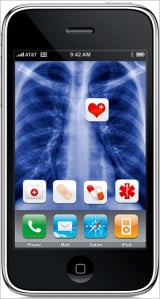
The workshop itself came about as a follow-on to the paper CHIP researchers Mandl and Kohane published in NEJM last March. Maybe with all that ARRA money floating about in the HITECH Act, ONC should just go ahead and build such an “Open” platform that supports modular apps to meet specific needs wihin this highly fragmented market.
Seriously, this needs some consideration.
Congress did grant authority in the ARRA legislation for HHS to develop an open-source EHR if existing vendor solutions do not adequately meet market needs. So, rather than build a full-fledge EHR which is almost doomed to fail in the market (despite what VistA promoters may argue) a better strategy may indeed be the building of an Open, iPhone-like platform with open SDK, open APIs, etc., heck, even throw in an AppStore (with an app review feature) and let the development community have at it. This could really get things moving and accelerate adoption of HIT, especially in small practices where 80% of care is delivered.
Are you listening Washington?




Cool. Modularity for extensibility, flexibility, and customization (and many other ilities) is a criteria I’d been thinking about when I was reviewing some EHRs and EMRs when I was trying to plan out an OS EMR.
There are many other design ideas that support modularity that would be more appropriate than the iPhone, but I think the iPhone is a salient one that people readily understand.
One such example is IBM’s Eclipse platform. It’s a platform on which their Java editor is built, but it has been used by other companies to build other products. For example, Adobe has used it to build their Flex Builder product, a commercial, source code editor for their Flex library. The eclipse RCP also has been repurposed for use in the Bioinformatics community to build an open source Bioinformatics analysis platform (BioEclipse).
One of the aspects of the RCP is the ability to find new plugins that can enhance the existing product, and for developers to provide hooks on which other developers can extend the functionality.
The Eclipse RCP is just one such example. There’s OSGI as another method for delivering modular pieces but I think Eclipse has really made it easy to do with their Updating mechanism.
Anyway, modularity was something I’d been thinking about when I was planning to start my own open source EMR implementation (scroll down to the Statement of Purpose):
http://applied-ux.com/healthtree/wiki/Main_Page
BTW, your link to CHIP’s platform page is broken.
Yes, iPhone platform and functionality are separate and consumers can choose from a variety of applications. But, to enter into the “marketplace” (iTunes app store) all vendors, all products must pass through the Apple approval process. Many documented frustrations over the lack of criteria for approval into the market. Many have argued varying degrees of judgment criteria. Not to forget the frustration that all apps must be developed using proprietary development tools, pay to register as an Apple developer, and be subjected to “Overreaching nondisclosure agreements (NDA)”.
These issues all seem to be in conflict with the principles discussed later in the article. For example, “certification requirements should be kept to a minimum”. The Apple developer program and approval process is nothing but one big bureaucratic certification process.
Is this what we want?
@wr Good points. The NEJM article provides a more detail, analogies, and comparisons to other interop/substitutable systems. I think the iPhone analogy was used because it’s easy for non-techies to understand and the iPhone and how it works is something people are used to.
John,
WR posted some good remarks on the drawback of iPhone and Apple. The way that Apple iPhone is structured today it would be nearly impossible to get anything close to what is being considered. An one of the worst infrastructure to module a open platform. It is a closed systems as WR mentioned and I thing the author was really referring to a Smartphone e.g., “iphone like”.
Android could be a top contender for this type of platform. It is open source written in Java and already running on Smartphones today. Since it is open source you can do whatever you would like, including a variant of the the OS. The tools and developing platform for Android are not tied to the platform.
Speaking to protocol, there are a lot of open source protocols now. XML is one of the best and easiest to implement. HL7 is already working with XML.
Great idea,
Jeff Brandt – motionPHR the MOBILE Personal Health Record for the iPhone
MyMedBox – lite version for Android
Thanks for all the comments everyone and rcadena, believe you are the one who best understood the meaning of the post.
What Chilmark was suggesting is NOT to have an EHR ecosystem within the Aple AppStore – yes, we have heard many a story of the opaque approval process that Apple uses for iPhone apps and no, this would definitely NOT work within the context of HIT for a whole host of reasons, including transparency, security, privacy, etc. and as WR and Jeff point out, certainly not “Open.”
But what we were suggesting and quite obviously, the researchers from CHIP, is an “iPhone-like platform” that would support modular app development with a common infrastructure. Such an infrastructure would be able to address many o the more common requirements of meaningful use, e.g., quality reporting, data exchange for care coordination but likewise provide flexibility for physicians to choose the apps that best fit their workflow, their specialty. Jeff and rcadena, like both the IBM Eclipse-type model (though it may need more structure or HIT) and a modified HIT-centric Android.
And hey, with the tens of billions of dollars that will be spent HIT adoption over the next several years, why not spend a fraction of that to create such an open platform? After all, HHS does have a green light to go out and create an EHR, which is full o political risks and backlash from HIT vendors. So rather than directly compete with the HIT vendors, create that open platform that even they can develop apps for.
John,
Good points. I think I understand what CHIP is asking for is a Layer 7 (OSI) application http://www.webopedia.com/quick_ref/OSI_Layers.asp. That is, a application framework to build process modules which provides the end users or management the ability to select workflow. Yes, this is a great idea which EMR/PHR vendors could build or adapt their apps to. In the Web world this type of workflow process is offered to vendors as Application servers such as BEA and ATG. There are also products like WebMethods which may operate on a Application server that provide specific business needs. ATG has the concept of a pipeline where a vendor can insert work modules into the pileline which perform processes on the data in the pipe. A medical example would be a module for release notes or other types of orders for a patient.
With the bandwidth speeds that we are starting to achieve with smartphones a Cloud application (web apps) with a smartphone clients may also be a viable option. A Cloud system would provide the most flexibility and reduce cost and HIT management.
An application/process server for a Smartphone, I like it.
Let me know what you think. This is some exciting stuff.
Jeff Brandt, “motionPHR” the Mobile Personal Heath Record for the iPhone.
There is a good article I co-authored on Health Apps and eGame front ends to PHR/EMR systems people might find informative at Virtual Medical Worlds web site – http://www.hoise.com/vmw/09/articles/index.html#15